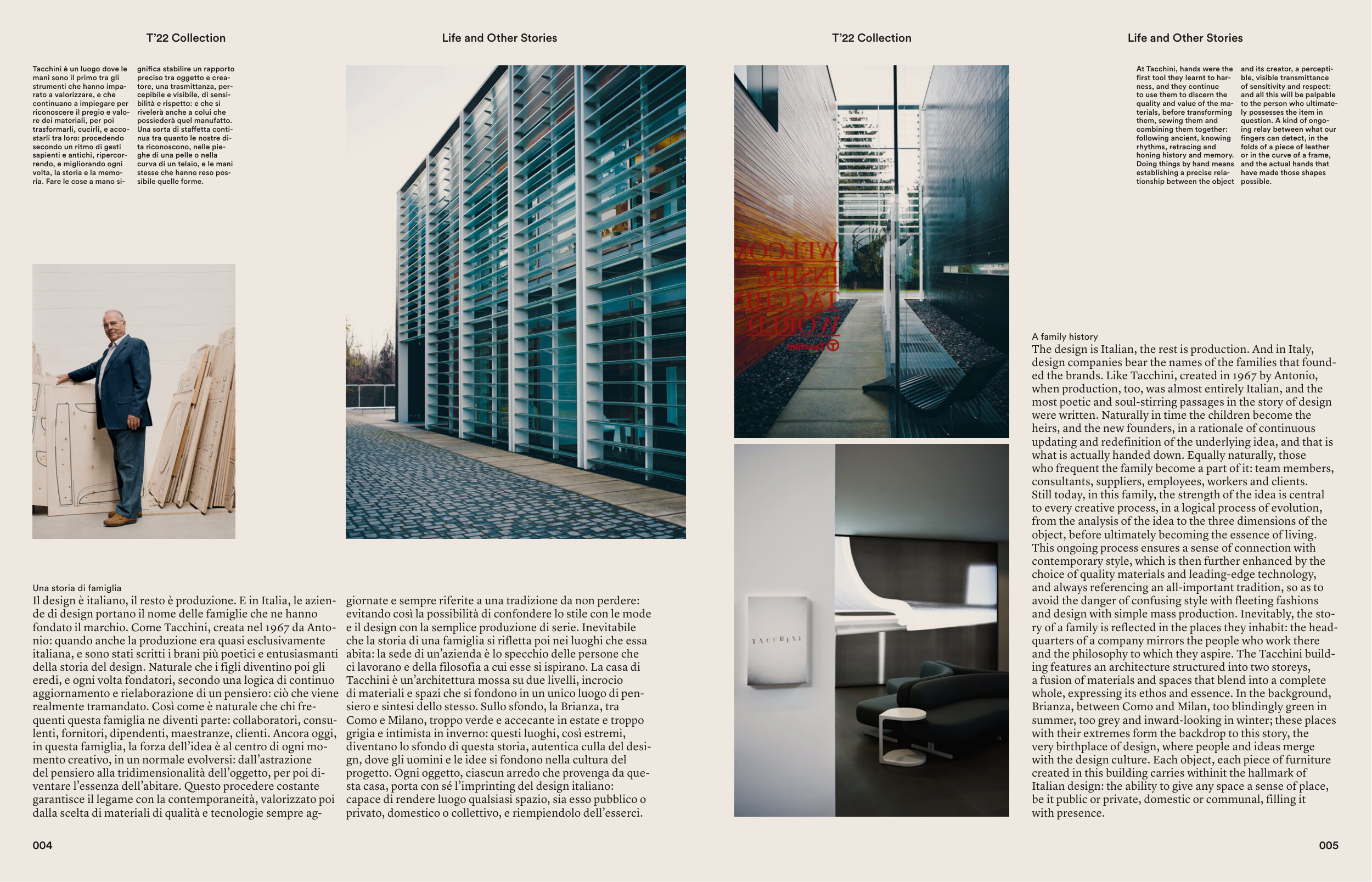Life and Other Stories
T’22 Collection
A family history
The design is Italian, the rest is production. And in Italy,
design companies bear the names of the families that found-
ed the brands. Like Tacchini, created in 1967 by Antonio,
when production, too, was almost entirely Italian, and the
most poetic and soul-stirring passages in the story of design
were written. Naturally in time the children become the
heirs, and the new founders, in a rationale of continuous
updating and redefinition of the underlying idea, and that is
what is actually handed down. Equally naturally, those
who frequent the family become a part of it: team members,
consultants, suppliers, employees, workers and clients.
Still today, in this family, the strength of the idea is central
to every creative process, in a logical process of evolution,
from the analysis of the idea to the three dimensions of the
object, before ultimately becoming the essence of living.
This ongoing process ensures a sense of connection with
contemporary style, which is then further enhanced by the
choice of quality materials and leading-edge technology,
and always referencing an all-important tradition, so as to
avoid the danger of confusing style with fleeting fashions
and design with simple mass production. Inevitably, the sto-
ry of a family is reflected in the places they inhabit: the head-
quarters of a company mirrors the people who work there
and the philosophy to which they aspire. The Tacchini build-
ing features an architecture structured into two storeys,
a fusion of materials and spaces that blend into a complete
whole, expressing its ethos and essence. In the background,
Brianza, between Como and Milan, too blindingly green in
summer, too grey and inward-looking in winter; these places
with their extremes form the backdrop to this story, the
very birthplace of design, where people and ideas merge
with the design culture. Each object, each piece of furniture
created in this building carries withinit the hallmark of
Italian design: the ability to give any space a sense of place,
be it public or private, domestic or communal, filling it
with presence.
At Tacchini, hands were the
first tool they learnt to har-
ness, and they continue
to use them to discern the
quality and value of the ma-
terials, before transforming
them, sewing them and
combining them together:
following ancient, knowing
rhythms, retracing and
honing history and memory.
Doing things by hand means
establishing a precise rela-
tionship between the object
and its creator, a percepti-
ble, visible transmittance
of sensitivity and respect:
and all this will be palpable
to the person who ultimate-
ly possesses the item in
question. A kind of ongo-
ing relay between what our
fingers can detect, in the
folds of a piece of leather
or in the curve of a frame,
and the actual hands that
have made those shapes
possible.
T’22 Collection
Life and Other Stories
giornate e sempre riferite a una tradizione da non perdere:
evitando così la possibilità di confondere lo stile con le mode
e il design con la semplice produzione di serie. Inevitabile
che la storia di una famiglia si rifletta poi nei luoghi che essa
abita: la sede di un’azienda è lo specchio delle persone che
ci lavorano e della filosofia a cui esse si ispirano. La casa di
Tacchini è un’architettura mossa su due livelli, incrocio
di materiali e spazi che si fondono in un unico luogo di pen-
siero e sintesi dello stesso. Sullo sfondo, la Brianza, tra
Como e Milano, troppo verde e accecante in estate e troppo
grigia e intimista in inverno: questi luoghi, così estremi,
diventano lo sfondo di questa storia, autentica culla del desi-
gn, dove gli uomini e le idee si fondono nella cultura del
progetto. Ogni oggetto, ciascun arredo che provenga da que-
sta casa, porta con sé l’imprinting del design italiano:
capace di rendere luogo qualsiasi spazio, sia esso pubblico o
privato, domestico o collettivo, e riempiendolo dell’esserci.
Una storia di famiglia
Il design è italiano, il resto è produzione. E in Italia, le azien-
de di design portano il nome delle famiglie che ne hanno
fondato il marchio. Come Tacchini, creata nel 1967 da Anto-
nio: quando anche la produzione era quasi esclusivamente
italiana, e sono stati scritti i brani più poetici e entusiasmanti
della storia del design. Naturale che i figli diventino poi gli
eredi, e ogni volta fondatori, secondo una logica di continuo
aggiornamento e rielaborazione di un pensiero: ciò che viene
realmente tramandato. Così come è naturale che chi fre-
quenti questa famiglia ne diventi parte: collaboratori, consu-
lenti, fornitori, dipendenti, maestranze, clienti. Ancora oggi,
in questa famiglia, la forza dell’idea è al centro di ogni mo-
mento creativo, in un normale evolversi: dall’astrazione
del pensiero alla tridimensionalità dell’oggetto, per poi di-
ventare l’essenza dell’abitare. Questo procedere costante
garantisce il legame con la contemporaneità, valorizzato poi
dalla scelta di materiali di qualità e tecnologie sempre ag-
Tacchini è un luogo dove le
mani sono il primo tra gli
strumenti che hanno impa-
rato a valorizzare, e che
continuano a impiegare per
riconoscere il pregio e valo-
re dei materiali, per poi
trasformarli, cucirli, e acco-
starli tra loro: procedendo
secondo un ritmo di gesti
sapienti e antichi, ripercor-
rendo, e migliorando ogni
volta, la storia e la memo-
ria. Fare le cose a mano si-
gnifica stabilire un rapporto
preciso tra oggetto e crea-
tore, una trasmittanza, per-
cepibile e visibile, di sensi-
bilità e rispetto: e che si
rivelerà anche a colui che
possiederà quel manufatto.
Una sorta di staffetta conti-
nua tra quanto le nostre di-
ta riconoscono, nelle pie-
ghe di una pelle o nella
curva di un telaio, e le mani
stesse che hanno reso pos-
sibile quelle forme.
005
004


